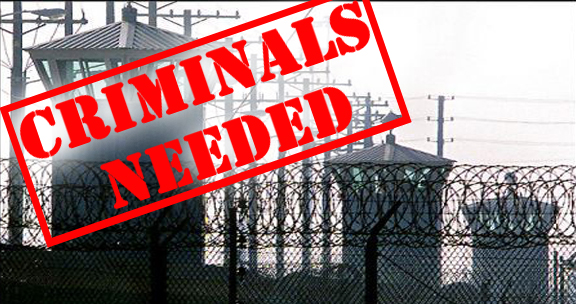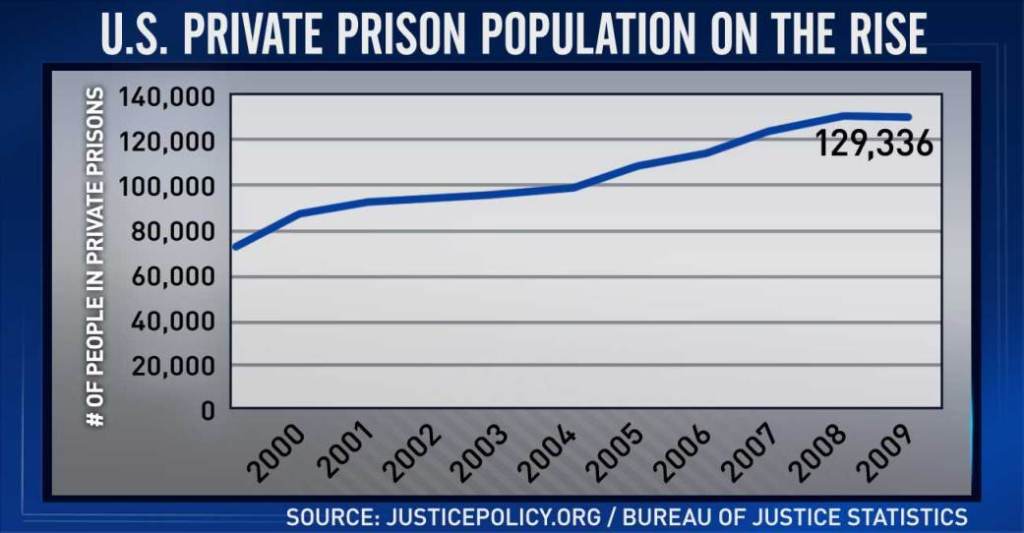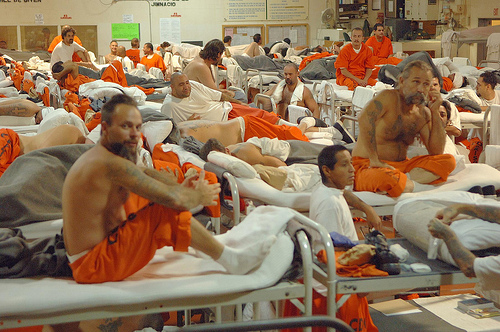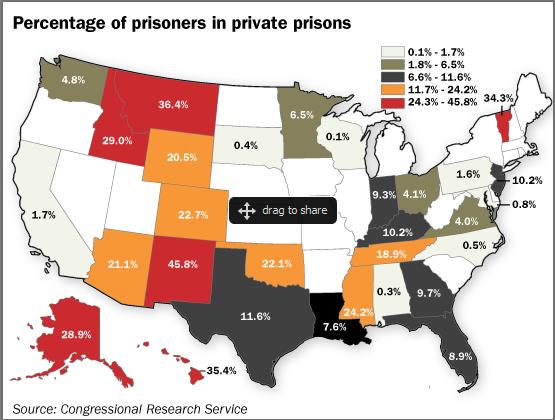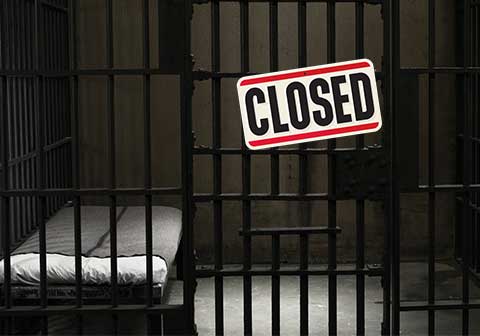PRIVATE PRISONS COSTS US ALL
Here in the United States, we have the largest prison population in the entire world. Although prison populations have increased throughout civilized nations, the U.S. outpaces all other industrialized countries incarceration rates by nearly 5 to 1! Simply put, the natural incarceration rate among other modern nations similar to the U.S. trends at 100 prisoners per 100,000 residents, however, here in the United States, the rate is over 500 prisoners per 100,000 residents which equates to 1.6 million prisoners according to data from the Bureau of Justice Statistics (BJS).
What may be even more troubling are the disparities among ethnic minorities and racial classifications. Black men are incarcerated at rates of 3,074 per 100,000 residents, and Latinos at rates of 1,258 per 100,000, compared to white men who are incarcerated at just 459 per 100,000 residents. Invariably, young black men (ages 18-34) are at least six times more likely to be incarcerated than young white men, according to a recent analysis by Becky Pettit, a University of Washington sociologist.
It is no question that people of color are disproportionately affected by mass incarceration in the United States. However, all Americans bear the brunt of the crippling costs associated with increasing prison populations that saddles both federal and state government budgets across the nation. Many government agencies have turned to the private prison industry for relief from rising costs.
Privatization to the Rescue
The privatization of U.S. prisons has become a booming private enterprise. Gaining popularity since the early 1980’s, coincidentally, coinciding with the increase of the war on drugs. The U.S. Department of Justice own reports, show U.S. private prison populations have grown 37 percent from 2002 to 2009 alone. At the heart of it all, private prison industry lobbying, has grown exponentially by 165 percent.
As ThinkProgress reported, private prisons haven’t just expanded their political influence by expending lobbying dollars, they’ve also been remarkably apt at placing friendly lawyers and lobbyists in the offices of major decision-makers like Gov. Jan Brewer (R-AZ), famous for executing the now infamous Senate Bill, SB1070, a harsh anti-immigrant law designed to increase prison populations.
The number of private prisons operating in the U.S. has increased from 5 in 1998 to 100 by 2008. Leading the pack, Corrections Corporation of America (CCA), the nation’s largest private prison corporation, has seen over 500 percent profit growth over the last twenty years. As reported, in 2010, the two largest private prison corporations alone received nearly $3 billion in revenue, while their top executives each received annual compensation packages worth well over $3 million.
As Brave New Foundation’s Jesse Lava puts it, the privatization of federal and state prisons “illustrates how greed has become a major driver of mass incarceration—and how the system is more vast [sic] than most citizens imagine.”
States Must Promise to Keep Occupancy Rates at 90% or Above
The Nation reported that CCA officials sent letters to forty-eight governors, offering to take their prison systems off state hands in exchange for a guarantee that their states would keep their facilities up to ninety percent full—regardless of crime rates. Essentially, states in keeping up with their promises, demand higher conviction rates from state and local prosecutors, judges and lawmakers. Even where criminal activity has diminished, and prison populations reduced, private prison corporations continue to demand bed guarantee provisions in their contracts. These types of guarantee’s made by state officials only serve to exacerbate the already existing inequalities in the U.S. justice system
But Less Government Oversight Increases Efficiency, Right?
Wrong! Facilities run by private prison corporations are not subjected to the same oversight as state and federal prisons. Lack of transparency, regulation and oversight has only led to deteriorating conditions which in turn, has led to a multitude of multi-million dollar lawsuits and government fines. All of which, invariably makes its way out of tax-payer’s pockets. As Alex Friedmann, editor of Prison Legal News, who himself was once incarcerated at a private prison has pointed out, “the private prison industry operates in secrecy while being funded almost entirely with public taxpayer money.” In September Bloomberg reported that “the federal government provided almost 43 percent of [CCA’s] $1.76 billion of revenue in 2012, according to its annual report.”
According to the Nation, CCA, and Geo Group, the second largest private prison corporation, have become notorious for providing substandard and sometimes harrowing living conditions to their prisoners. State and federal regulation is necessary to equalize the vast disparities in dollar-for-dollar spending costs on public and privately ran prisons. However, lawmakers are slow to react, if not turning a blind eye all together. As the Arizona Republic’s editorial board pointed out, in a bill passed in 2012, Arizona’s overwhelmingly Republican Legislature effectively eliminated the statutory requirement for the Arizona Department of Corrections to do a cost comparison between public and private prisons. Furthermore, it eliminated the previous statutory requirement for regular comparisons of services provided by private and public prisons, including a hard look at servces such as; security, prisoner health and the safety of facilities. It was signed into law by Gov. Jan Brewer, who has long been a supporter of private prisons. Transparency will be the key element to shedding light on the billions of tax-payer dollars lining the pockets of wealthy investors and share-holders.
Progress, Slow but Progress Nonetheless
While there remains much work to be done in reforming America’s love affair with the capitalization of bondage, some progress is being pursued. For instance, the Private Prison Information Act, legislation first introduced over nine years ago, has again garnered support for its reintroduction. Specifically, Texas Congressional Representative, Sheila Jackson Lee, has reintroduced the failed legislation attempt that would require anyone with a federal prison contract—to “make the same information available to the public that Federal prisons and correctional facilities are required to make available.”
In addition, baby steps have also been made by other federal agencies reigning in run-away profits off the prison industry. Pointedly, the Federal Communications Commission (FCC) has finally capped the seemingly unlimited astronomical rates charged by private telecommunications providers to inmates in order to communicate with loved ones on the outside world.
Moreover, Idaho’s Department of Corrections have recently announced that it will take back control of its privately ran prison industry citing over a decade of mismanagement and other problems at the facility including multiple lawsuits alleging rampant violence, under-staffing, gang activity and contract fraud by CCA.
Conclusion
The Privatization of essential public functions, such as healthcare, incarceration, and rehabilitation have all had the polar opposite effects of their intentions, driving down costs. When you place profits above all else, undoubtedly, the cost of doing business will rise. Footing the bill for this privatization craze are the American tax-payers like you and me who end up paying far more for far less.
Many will attempt turn these debates into arguments over being “tough on crime,” or the inefficiency of government, however, those arguments have failed in the past and will continue to fail whenever we place profits above people. Those who stand to benefit from de-privatization are not just criminals, but the hard working American people who are seeing their tax dollars funneled into private bank accounts.
